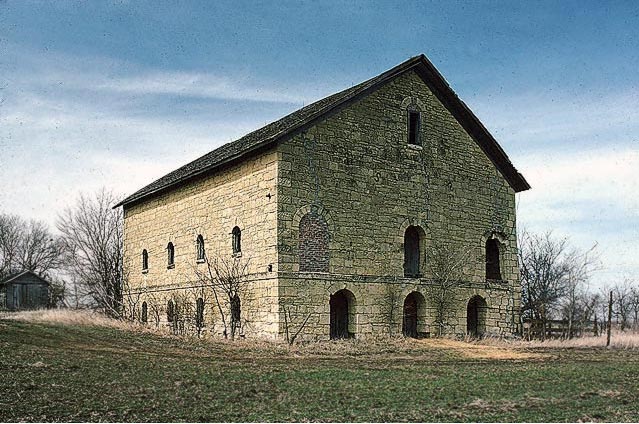
Few barns in Nebraska Territory were as substantial as the Elijah Filley Stone Barn, built in 1874 in Gage County. It is now on the National Register of Historic Places. NSHS Historic Preservation GA00-001
“Why is it there are no barns in this Territory?” asked the Nebraska Farmer in December 1861. “In all of the Middle States-even among the very first settlers, a barn was considered indispensable by every farmer. Farmers, from New York and Pennsylvania, who emigrated to the then Far West, built a good barn before they had a comfortable house. But here, no matter where the emigrant is from, he never thinks of building a barn. Yet barns are just as important here as anywhere else. We have not yet seen a good barn in this [Nebraska] Territory. We have been told that Mr. Strong has one in the southern part of this county [Nemaha]; and we are also informed that there are one or two in Cass county, but as a general thing there are no barns here. The reasons are: The scarcity of timber and the high price of lumber, and the want of sufficient capital on the part of our farmers.
“One great calamity in this Territory is that so many came here who are not able to carry on the business of a farm in a manner to be profitable. Another trouble is, they try to farm too much land, thus depriving themselves of all money for improvements, and for stocking their farms. The consequence is that one half of our farmers are scarcely able to procure the necessities of life for themselves and families. They are barely able to ‘make ends meet,’ and are constantly harassed, like a ‘toad under a barrow,’ until life is almost a burden.
“They are always compelled to work to a disadvantage. Their crops are improperly ‘put in,’ and still worse harvested. They must be content with a ‘three-rail fence,’ and lose a portion of their crop by their neighbor’s or their own stock. They lose a fourth of their wheat by its getting wet in the stack; and when threshed, the machines they employ, beside the customary toll, in many instances, wasted one fourth of the balance. They are not able to stock their farms, but are necessitated to sell their grain when the market is the lowest-if corn sells but for ten cents a bushel, they must exchange it for clothing for their children.
“Many of this class will never be able to live in a better style, unless a very fortunate year should ‘give them a lift.’ It would be nonsense to advise such to ‘build a barn.’ It would be a physical impossibility for them to do it. ‘Blood cannot be extracted from a turnip.’ But men who are able to buy three hundred and twenty acres of land, and to fence and cultivate eighty or a hundred acres, could, if they purchased but eighty acres, and farmed but thirty of it, have built a barn sufficiently large, and yet have made as much money as now. And in ten years they could have owned more land, (even if they did not enter it at Government price,) than they will at the end of that time by the present system of farming.”



